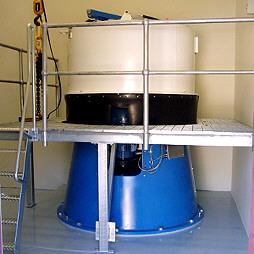Posted 10 May 2011

Most of the major centrifuge components in place.
A world class centrifuge permeameter facility has been commissioned for the National
Centre for Groundwater Research and Training (NCGRT).
Funded by the Australian Research Council and National Water Commission, the facility was constructed during 2010 and commissioned in early 2011 at the UNSW Water Research Laboratory, located on Sydney's northern beaches.
Engineers from Broadbent in the UK prepared the centrifuge for its successful first flight on March 21. Development and testing of sensors, instruments and data acquisitions systems within the challenging high gravity environment is continuing.
The new facility, including a Broadbent G-max geotechnical centrifuge, will be available to researchers from various agencies, and will provide services to industry.
It is one of only two large centrifuge permeameters in the world, capable of measurements during flight. It's the only centrifuge permeameter capable of testing 100 mm diameter drill core which is essential for measuring permeability of swelling clay. It will also be able to test standard 65 mm drill core of sediments and rock.
The key research questions to be addressed by this innovative research facility include:
The centrifuge permeameter enables rapid and repeatable testing of hydraulic conductivity. Matrix scale testing can be used to constrain numerical flow models and help identify the significance of preferential flow pathways. Further development of instrumentation at the new facility will also enable, in the future, testing of effective porosity, compressibility and attenuation of contaminants.
Competitive PhD scholarships are available to suitable candidates to help pioneer centrifuge permeameter technology for environmental research. Click here fore more information.
Development of the centrifuge permeameter facility forms part of the NCGRT aquitard research program, which also involves development of field geophysical methods for in-situ characterisation. Numerical modelling of aquitard barrier integrity has also commenced.
Please contact w.timms@wrl.unsw.edu.au with enquiries for core testing or collaborative research. Click here for a sample submission form.

Professor Andy Baker features in American Water Resources Association ‘Water Resources Impact’, September 2020 edition.

The Connected Waters Initiative (CWI) is pleased to welcome Taylor Coyne to its network as a postgraduate researcher. If you’re engaged in research at a postgraduate level, and you’re interested in joining the CWI network, get in touch! The CWI network includes multidisciplinary researchers across the Schools of Engineering, Sciences, Humanities and Languages and Law.

The Grand Challenge on Rapid Urbanisation will establish Think Deep Australia, led by Dr Marilu Melo Zurita, to explore how we can use our urban underground spaces for community benefit.

On the 21 August 2020, CWI researchers made a submission to the National Water Reform Inquiry, identifying priority areas and making a number of recommendations as to how to achieve a sustainable groundwater future for Australia.

Results published from a research project between the Land Development Department (LDD) Thailand and UNSW has demonstrated how 2-dimensional mapping can be used to understand soil salinity adjacent to a earthen canal in north east Thailand (Khongnawang et al. 2020).